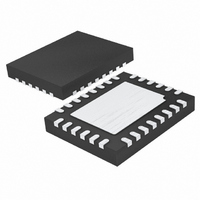LTC3557EUF-1#TRPBF Linear Technology, LTC3557EUF-1#TRPBF Datasheet - Page 19

LTC3557EUF-1#TRPBF
Manufacturer Part Number
LTC3557EUF-1#TRPBF
Description
IC USB POWER MANAGE 28-QFN
Manufacturer
Linear Technology
Datasheet
1.LTC3557EUFPBF.pdf
(28 pages)
Specifications of LTC3557EUF-1#TRPBF
Applications
Handheld/Mobile Devices
Voltage - Supply
4.35 V ~ 5.5 V
Operating Temperature
-40°C ~ 85°C
Mounting Type
Surface Mount
Package / Case
28-QFN
Lead Free Status / RoHS Status
Lead free / RoHS Compliant
Current - Supply
-
Available stocks
Company
Part Number
Manufacturer
Quantity
Price
Step-down Switching Regulator Dropout Operation
It is possible for a step-down switching regulator’s input
voltage to approach its programmed output voltage (e.g., a
battery voltage of 3.4V with a programmed output voltage
of 3.3V). When this happens, the PMOS switch duty cycle
increases until it is turned on continuously at 100%. In this
dropout condition, the respective output voltage equals the
regulator’s input voltage minus the voltage drops across
the internal P-channel MOSFET and the inductor.
Step-Down Switching Regulator Soft-Start Operation
Soft-start is accomplished by gradually increasing the peak
inductor current for each step-down switching regulator
over a 500μs period. This allows each output to rise slowly,
helping minimize inrush current required to charge up the
switching regulator output capacitor. A soft-start cycle
occurs whenever a given switching regulator is enabled,
or after a fault condition has occurred (thermal shutdown
or UVLO). A soft-start cycle is not triggered by changing
operating modes. This allows seamless output transition
when actively changing between operating modes.
Step-Down Switching Regulator Switching
Slew Rate Control
The step-down switching regulators contain new patent-
pending circuitry to limit the slew rate of the switch node
(SW1, SW2 and SW3). This new circuitry is designed to
transition the switch node over a period of a couple nano-
seconds, signifi cantly reducing radiated EMI and conducted
supply noise while maintaining high effi ciency.
Step-Down Switching Regulator Low Supply Operation
An undervoltage lockout (UVLO) circuit on V
down the step-down switching regulators when V
below about 2.7V. It is recommended that the step-down
switching regulators input supplies be connected to
the power path output (V
step-down switching regulators’ from operating at low
supply voltages where loss of regulation or other un-
desirable operation may occur. If driving the step-down
switching regulator input supplies from a voltage other
than the V
OPERATION
OUT
pin, the regulators should not be operate
OUT
). This UVLO prevents the
OUT
OUT
drops
shuts
outside the specifi ed operating range as operation is not
guaranteed beyond this range.
Step-Down Switching Regulator Inductor Selection
Many different sizes and shapes of inductors are avail-
able from numerous manufacturers. Choosing the right
inductor from such a large selection of devices can be
overwhelming, but following a few basic guidelines will
make the selection process much simpler.
The step-down converters are designed to work with
inductors in the range of 2.2μH to 10μH. For most
applications a 4.7μH inductor is suggested for step-down
switching regulators providing up to 400mA of output
current while a 3.3μH inductor is suggested for step-down
switching regulators providing up to 600mA. Larger value
inductors reduce ripple current, which improves output
ripple voltage. Lower value inductors result in higher
ripple current and improved transient response time,
but will reduce the available output current. To maximize
effi ciency, choose an inductor with a low DC resistance.
For a 1.2V output, effi ciency is reduced about 2% for
100mΩ series resistance at 400mA load current, and
about 2% for 300mΩ series resistance at 100mA load
current. Choose an inductor with a DC current rating at
least 1.5 times larger than the maximum load current to
ensure that the inductor does not saturate during normal
operation. If output short circuit is a possible condition,
the inductor should be rated to handle the maximum peak
current specifi ed for the step-down converters.
Different core materials and shapes will change the size/cur-
rent and price/current relationship of an inductor. Toroid
or shielded pot cores in ferrite or Permalloy materials are
small and don’t radiate much energy, but generally cost
more than powdered iron core inductors with similar
electrical characteristics. Inductors that are very thin or
have a very small volume typically have much higher
core and DCR losses, and will not give the best effi ciency.
The choice of which style inductor to use often depends
more on the price vs size, performance, and any radiated
EMI requirements than on what the step-down switching
regulators requires to operate.
LTC3557/LTC3557-1
19
35571fc














